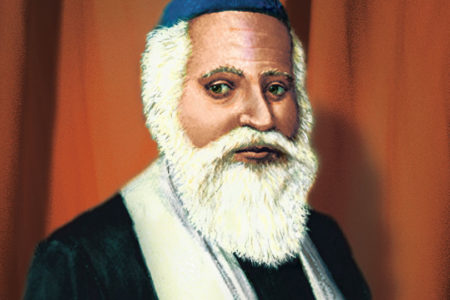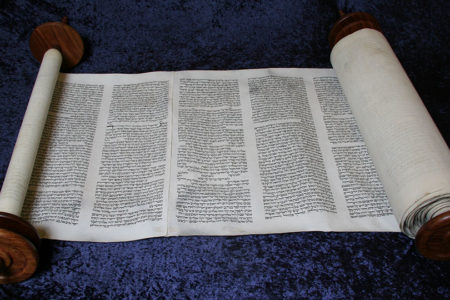The Dead Sea Scrolls’ True Treasure
The law of the Lᴏʀᴅ is perfect. More to be desired are they than gold,…and in keeping them there is great reward. The law of Your mouth is better to me than thousands of coins of gold and silver (Ps. 19:7, 10–11; 119:72).
Muhammad was flustered. His mischievous goat was missing. Roaming far from the herd and friends, the Bedouin came upon a cave overlooking the northwestern shore of the Dead Sea. Thinking the creature had strayed inside, he threw stones in to flush it out. When he heard the crack of pottery, he was baffled. Might there be a cache of treasure? He excitedly scampered down into the cave entrance to find no gold or silver, merely old, large clay jars along the wall, with tattered scrolls inside. At least the leather scrolls will make great sandal straps, he thought. Sadly, Muhammad could not appreciate the true worth of the moment. His naughty goat had led him to what has been called the greatest manuscript discovery of modern times: a priceless treasure hoard of the written Word—the Dead Sea Scrolls.
Bedouins do not keep time like Westerners, but like the ancients; they view time in connection with other events. So the exact date of the discovery is not certain. The new, revised date for the first scroll discovery is 1935 or 1936. From then through 1956, many more manuscripts were found. They are believed to date from the third century B.C. to the first century A.D. Most were found in the limestone caves in Qumran, just northwest of the Dead Sea. Most of the scrolls are in Hebrew; the rest are written in Aramaic and Greek. More than 900 documents, representing as many as 350 separate works in multiple copies, have been found. Many of the biblical and nonbiblical scripts are represented in tiny fragments. In one cave alone there were 520 texts in 15,000 fragments. As you can imagine, piecing them together for translation has been a gigantic task.
The discovery confirms what Bible believers have always known: Today’s Bible is a proven text. Regardless of the assaults against it, the Word of God stands forever.
As for God, His way is perfect; the word of the Lᴏʀᴅ is proven; He is a shield to all who trust in Him (2 Sam. 22:31).
There have always been some who have questioned the reliability of Scripture. Since the text has been copied and recopied over the centuries, critics claim it’s impossible to know with certainty what the biblical writers originally wrote or meant. The Dead Sea Scrolls void that assumption in regard to the Old Testament. Between 223 and 233 copies of the Hebrew Scriptures were discovered and compared with the present text. The only Old Testament book not found was Esther. Possibly it is still out in a desert cave somewhere.
Before the discovery, the oldest manuscripts of the Hebrew Scriptures dated from the ninth through the 11th centuries. These copies are referred to as the Masoretic Text, from the Hebrew word masorah, meaning “tradition.” Jewish scribes from Tiberias, called Masoretes, meticulously sought to standardize the Hebrew text and pronunciation; their work is still considered authoritative today. The Qumran scrolls are at least 1,000 years older than the Masoretic Text. In fact, the scrolls even predate the Septuagint, a Greek translation of the Old Testament produced in Egypt around 200 to 300 B.C.
Careful comparisons have been made between the Masoretic Text and the Dead Sea Scrolls. Only insignificant differences in spelling and grammar were found. Critics and skeptics were shocked at how closely the text resembles today’s. They found no direct challenges to the principal doctrines of Scripture. The biblical portion of the Qumran literature confirms the wording and meaning of our modern-day Old Testament:
You search the Scriptures, for in them you think you have eternal life; and these are they which testify of Me (Jn. 5:39).
Along with the copies of the Old Testament Scriptures, the Dead Sea caves also yielded other writings. These documents describe the lifestyle and beliefs of the mysterious community that lived in the Qumran area. Although nonbiblical, they are valuable for giving understanding to the times and culture of the New Testament era. Unfortunately, scholars focus more attention on these extraneous works than on the Scriptures, though the Bible texts are more relevant to life issues because God’s authorized redemption program for humanity is found only in them.
Amazing Accuracy
The Isaiah Scroll found in Cave One at Qumran presents a great example of accurate translation transmission. This extraordinary manuscript is believed to predate the birth of Jesus Christ by 100 years. It was a scroll like this that Jesus used when he read the following in the village synagogue at Nazareth: “The Spirit of the Lᴏʀᴅ is upon Me, because He has anointed Me to preach the gospel to the poor” (Lk. 4:18; cf. Isa. 61:1). He continued reading. Then He would have handed the scroll back to the attendant and sat down. While all eyes were fixed on Him, Jesus declared that portion of Scripture fulfilled in their ears. Thus He clearly declared Himself to be God’s Messiah, come to offer salvation to all who would receive it.
The same passage, translated into English directly from the 1,000-year-old Isaiah scroll discovered in Qumran, is nearly identical: “The Spirit of the Lord Gᴏᴅ is upon me, because ʏʜᴠʜ has anointed me to preach good tidings to the weak” (Isa. 61:1). The integrity of the claim, as written in our Bibles, is confirmed.
Fascinatingly, the scrolls most commonly found, either whole or in tiny fragments, are the same Bible books frequently quoted in the New Testament: Deuteronomy, Isaiah, and the Psalms. This fact is intriguing in light of Jesus’ own words involving the Hebrew Scriptures:
These are the words which I spoke to you while I was still with you, that all things must be fulfilled which were written in the Law of Moses and the Prophets and the Psalms concerning Me (Lk. 24:44).
Many more examples can be cited. The main fact concerning the Bible and the scrolls is what the great English preacher G. Campbell Morgan (1863–1945) once shared: “There is no life in the Scriptures themselves, but if we will follow where they lead, they will bring us to Him, and so we find life, not in the Scriptures, but in Him through them.”1
The grass withers, the flower fades, but the word of our God stands forever (Isa. 40:8).
Endless arguments and debates have arisen over the scrolls. Nevertheless, believers can be confident that the ancient biblical scripts confirm, collaborate, and uphold the Bible today. God’s Word is still the only true source for faith and doctrine to all who seek eternal reward:
More to be desired are they than gold, yea, than much fine gold; sweeter also than honey and the honeycomb. Moreover by them Your servant is warned, and in keeping them there is great reward (Ps. 19:10–11).
So poor Muhammad, who had hoped for the treasures of this world, found only tattered leather scrolls, good for making sandal straps! Sadly, worldly gain is a self-absorbing priority. The world considers the Scriptures worthless, good only for occasional lip service, but never to be believed or practiced. Yet we know better. We know not to overlook the true, priceless treasure that is only found when digging into God’s Word:
Yes, if you cry out for discernment, and lift up your voice for understanding, if you seek her as silver, and search for her as for hidden treasures; then you will understand the fear of the Lᴏʀᴅ, and find the knowledge of God (Prov. 2:3–5).
ENDNOTE
- Cited in Leon Morris, The Gospel According to John (Grand Rapids, MI: Eerdmans, 1971), 331 n. 116.







